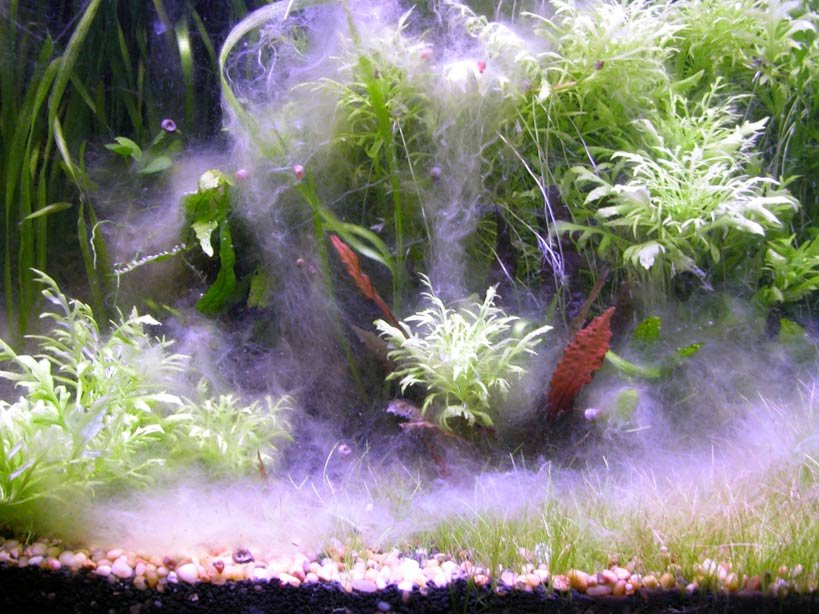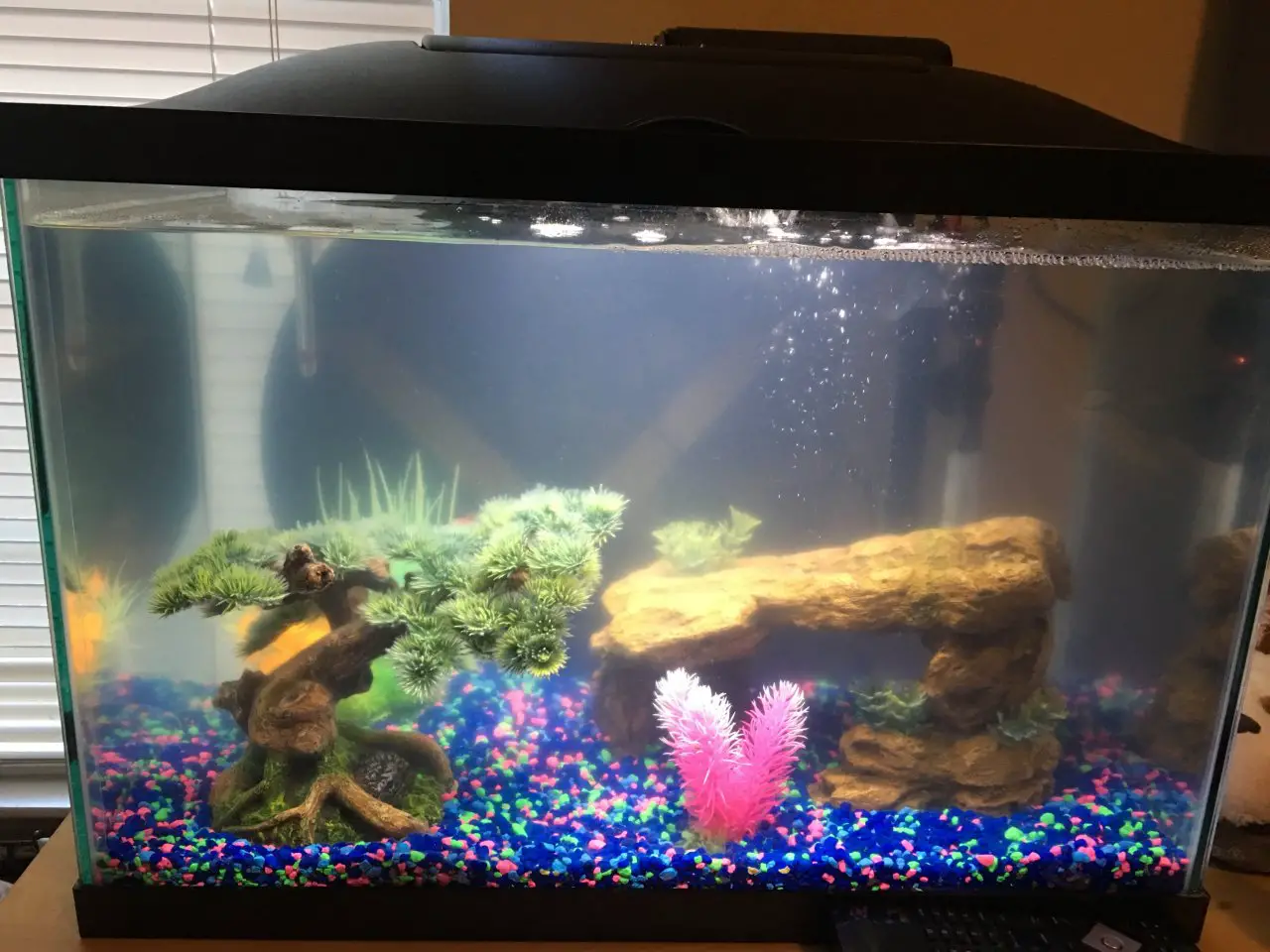To get rid of clear slime in a fish tank, the first step is to do a thorough water change. Remove at least 25% of the tank’s water and replace it with clean, chlorine-free tap water that has been treated with an aquarium safe dechlorinator. After replacing the water, use an aquarium vacuum cleaner or siphon to remove any debris from the gravel or surfaces of your tank.
This will help reduce excess nutrients in your tank that can cause further slime buildup. Next, you should increase aeration by adding an air stone or increasing circulation via power filters and/or wave makers.
This helps keep oxygen levels high which can limit bacteria growth. Finally, consider adding beneficial bacteria such as nitrifying bacteria additives to your filtration system and make sure the filter media is changed regularly.
Following these steps should help control clear slime in your fish tank over time without harming its inhabitants.
- Remove the Fish: Before attempting to remove any slime from your tank, it is important to first remove all of your fish and other aquatic life from the tank. This will protect them from any chemicals or cleaning agents you use during the process.
- Clean All Decorations: Take out all decorations and gravel from the tank and rinse it in a bucket with warm water mixed with aquarium-safe soap. Once all of this is thoroughly rinsed, place it back into the aquarium once everything has been dried off completely.
- Vacuum Gravel Bed: Use an aquarium vacuum cleaner to clean off built up debris that could be contributing to slimy growth on walls of your tank before wiping down surfaces with a sponge dipped in vinegar solution diluted in warm water (one part vinegar/three parts water). The acidity level of vinegar helps break down slime quickly without damaging glass or acrylic tanks surfaces while also killing bacteria that contribute to its growth.
- Replace Tank Water: After you have wiped down surfaces, replace 25-50% of old tank water with fresh water that has been treated for chlorine removal before adding any fish back into the environment; if possible add some beneficial bacteria as well which helps keep excess nutrients levels low within the system thus preventing slimy buildups due again over time.
Clear Slime in Betta Tank
Clear slime in a betta tank is an indication of healthy bacteria growth. Clear slime usually appears on the surfaces of aquariums and is created when beneficial bacteria form colonies that break down organics into harmless waste products.
This process helps keep your tank water clean and free from ammonia, nitrites, and other harmful compounds that can be toxic to your betta fish.
Clear Slime in Freshwater Fish Tank
Clear Slime in a freshwater fish tank is an indication that the water quality of your aquarium is off balance. The slime may be caused by an excess of nitrates, which can create an environment for bacteria to grow and form a slimy coating on any surface it touches.
To prevent this from happening, make sure you keep up with regular maintenance such as water changes and filter cleaning, as well as provide adequate aeration in the tank.
If you notice clear slime forming on the surfaces of your fish tank, add some beneficial bacteria to help restore the balance of your aquatic ecosystem.
Clear Slime in Aquarium Filter
Clear slime in an aquarium filter is a sign of healthy bacteria. It can help to break down toxic elements like ammonia, nitrogen and phosphates to keep your fish tank clean and safe for your aquatic creatures.
Clear slime can also be a sign that the filter has become clogged with debris or waste from overfeeding, so it’s important to check regularly for signs of excess build up in order to maintain water quality.
Clear Slime on Aquarium Glass
Clear slime on aquarium glass is actually a type of algae that can form when the water isn’t properly filtered or if there’s too much light in the tank. It usually appears as a slimy, clear layer on the sides and back of your tank.
Although it won’t harm your fish, it does reduce visibility and make for an unattractive appearance.
The best way to remove this slime is to use an aquarium scrubber or brush and gently scrape off any excess buildup from the glass.
Biofilm in Fish Tank
Biofilm is an essential component of a healthy fish tank. It refers to the naturally occurring layer of bacteria and organic matter that lines the surfaces of tanks, rocks, and other objects in your aquarium.
This biofilm provides important nutrients for beneficial bacteria to consume, helping maintain water quality by breaking down ammonia and nitrates into harmless compounds.
It serves as a food source for fry (baby fish) as well as a refuge for small invertebrates like snails or shrimp. With regular cleaning and maintenance, you can make sure your tank remains safe and healthy thanks to its protective biofilm!
Brown Slime in Fish Tank
Brown slime in a fish tank can be caused by several different issues, such as an over abundance of organic material or too much light exposure. If left untreated, the brown slime will continue to spread and could potentially harm your fish if they come into contact with it.
To prevent further growth of brown slime, you should clean your tank regularly using appropriate cleaning supplies and tools.
Additionally, you may want to reduce the amount of light in your tank to discourage the growth of algae which is usually what causes this type of slime buildup.
Green Slime in Fish Tank
Green slime in a fish tank is a common issue that can cause serious harm to your fish if left untreated. It’s caused by an overabundance of nutrients, usually from uneaten food or decaying plants, which causes algae growth in the water.
To remove green slime from your aquarium, you’ll need to do regular partial water changes and increase the oxygen levels in the tank.
You may also need to reduce feeding amounts and adjust light levels if they’re too high. Regular maintenance will help keep green slime under control, so be sure to check on your tank every week!
White Slime on Fish
White slime on fish is not uncommon and is usually caused by a bacterial infection. This type of infection is generally harmless to the fish, but it can be unsightly and may lead to other complications if left untreated.
The most common treatment for white slime on fish is an antibiotic bath or spot treatment with a water-soluble medication, such as Kanaplex or Triple Sulfa.
It’s important that you consult your vet before attempting any treatments for this condition so that you can ensure the best possible outcome for your pet.

Credit: fishlab.com
Why is There Clear Slime in My Fish Tank?
Clear slime in fish tanks is usually caused by a combination of bacteria and proteins, which together form a slimy film on the surfaces of the aquarium. This slime can be beneficial to your tank’s inhabitants as it helps keep water clean, provides food for certain species of fish and invertebrates, and is even thought to protect against certain diseases.
However, too much clear slime can mean that there are too many nutrients in the tank or that something else may be causing an excess buildup.
It could also indicate an imbalance in your tank’s chemistry such as pH levels being off or nitrates that are too high. In any case, you should take steps to remedy it if you find excessive amounts of clear slime present in your aquarium.
These steps include increasing water turnover rate (to reduce nutrient accumulation), performing partial water changes regularly (to remove organic waste from the system).
Introducing algae-eating fishes like snails or shrimp (which will help consume excess proteins). Adding oxygenating plants like Anacharis or Hornwort (which will absorb some of the nitrogenous wastes).
Finally, make sure to test your water parameters frequently so that you know when something needs adjusting before problems arise!
Is Slime Algae Bad for Fish?
Slime algae, or cyanobacteria, can be a nuisance in any fish tank. It has an unsightly appearance and can cause poor water quality if left untreated. However, some species of slime algae are actually beneficial to fish health. They provide shelter for fry (young fish) and serve as a source of food for some species.
While it is not always harmful to have slime algae in your aquarium, it is important to understand that there are certain types which can be damaging to the overall health of your aquatic life.
In particular, toxic varieties such as Oscillatoria spp., Lyngbya spp., Phormidium spp., and Microcystis aeruginosa release toxins which can be dangerous to both plants and animals living in the same environment.
If you notice large accumulations of these types of slime algae blooms growing in your aquarium it may be time to take action by increasing water circulation levels or using chemical treatments that will help reduce their growth rate.
Knowing how to identify different types of slime algae is key when determining whether they pose a potential threat or benefit your aquatic inhabitants – so make sure you do your research before making any decisions!
What is a Clear Jelly Like Algae?
A clear jelly like algae, known as aegagropila linnaei and commonly referred to as “Marimo”, is an aquatic species native to lake and river ecosystems. This unique species has spherical shapes that can range from the size of peas to softballs.
Marimo is known for its velvety texture and its ability to roll along the bottom of lakes when it’s disturbed by currents or waves.
The algae usually grows in colonies near the shoreline but can sometimes be found further out in deeper water. While Marimo looks similar to other types of plant life, it isn’t actually considered a true plant because it doesn’t produce any food from photosynthesis; instead, it gets energy from absorbing organic matter floating in the water around them.
Despite not being able to photosynthesize, Marimo is still capable of growing over time with proper care – this includes regular maintenance such as changing their water regularly and using aquarium gravel for substrate so they can attach themselves securely for stability.
This rare species makes for an interesting addition to any tank or pond setting, providing unique character and color!
What is the Slimy Film on My Aquarium Glass?
The slimy film that you may have noticed on your aquarium glass is likely a form of algae known as diatoms. Diatoms are photosynthetic, single-celled organisms that contain silica in their cell walls.
They can be found in both saltwater and freshwater tanks, thrive off the natural sunlight entering through the tank walls, and produce oxygen as a byproduct.
Since diatoms require light to survive, they tend to accumulate more heavily near the surface where there is more direct exposure to it. This can result in an unsightly coating on your aquarium glass sometimes referred to as “diatom slime”.
Fortunately, this issue is relatively easy to remedy by regularly scrubbing down the sides of your tank with an algae pad or brush during water changes or simply wiping them down with some vinegar or lemon juice solution you should quickly be able to restore clarity within your tank’s environment!
Conclusion
It is important to take measures to ensure that clear slime does not build up in your fish tank. Regularly cleaning the tank, substrate and decorations will help you reduce the amount of debris and bacteria that can lead to clear slime.
Timely water changes are vital for maintaining healthy aquarium conditions which will also prevent excessive amounts of clear slime from forming.
By following these steps and keeping on top of routine maintenance tasks, you should be able to keep your fish tank free from clear slime and offer a healthy environment for your fish.

